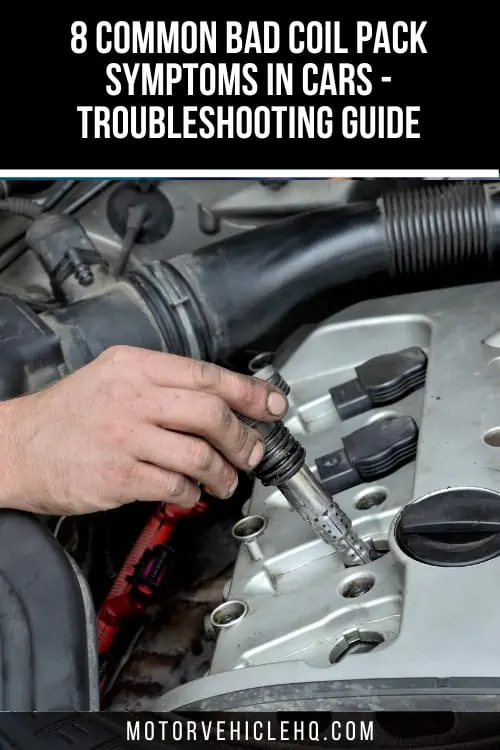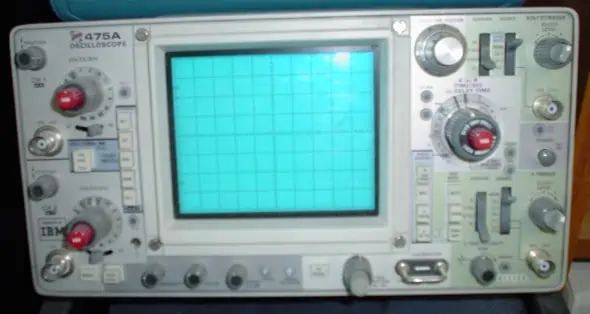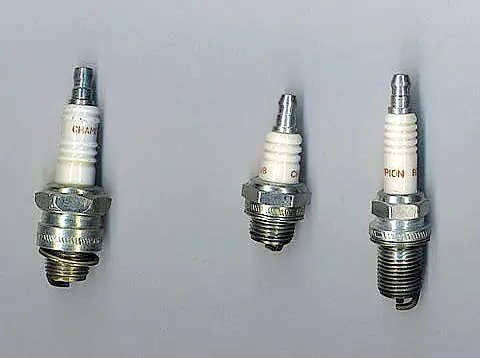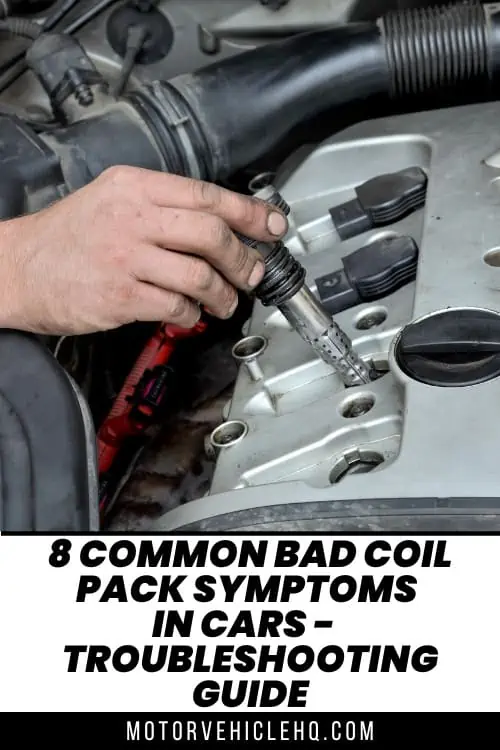Is your car having trouble starting? Are you having trouble starting the car? These are only a few indications that you are likely experiencing bad coil pack symptoms. You may want to inquire what a coil pack is. Simply described, it’s a pack of ignition coils controlled by electronics.
A coil pack is a collection of ignition coils that are used in the ignition system of a car. On new and contemporary vehicles, it takes the place of the distributor because coil packs are more dependable than distributors.
The computer in the car electrically controls and regulates the coil pack. You may experience several bad coil pack symptoms, and you should be aware of them because they may indicate a more significant problem with the engine’s performance.
This is not surprising considering that a coil pack is in charge of storing the energy and turning the battery’s 12-volt output into as much as 45,000 volts before transferring it through the spark plug cables to the spark plug to begin the combustion process.
All coil packs will be covered in this post’s discussion. From the bad coil pack symptoms to the procedure on how you can test them, After that, we’ll also inform you of any potential replacement costs.
A Coil Pack: What Is It In a Car?
A coil pack is, as previously said, a group of ignition coils. It takes over the function of the distributor coil found in more traditional vehicles and is electronically managed by the car’s computer to ignite each spark plug in an engine cylinder. The coil pack builds up 50,000 to 70,000 volts of voltage from the battery of your vehicle, which it then passes to the spark plug via the spark plug connections.
Coil-pack of an Opel engine by Cschirp / CC BY-SA 3.0 de. Your car’s battery supplies the coil pack with 50,000 to 70,000 volts of electricity, which it then transfers to the spark plug via the spark plug connectors to start the combustion process.
The combustion process then begins when the spark ignites the fuel and air mixture inside your engine’s cylinders. Simply put, it initiates the combustion process by transferring electricity from your battery to produce a spark.
The ignition coil is necessary for your engine to run unless it is a diesel. Your vehicle won’t operate properly or even start if it were to malfunction. In contrast, a diesel engine does not require spark plugs or ignition coils to begin the combustion process because of the tremendous compression within the cylinders.
Diesel engines frequently operate more consistently due in part to the fact that they don’t require ignition coils and spark plugs to function. Therefore, if you drive a diesel vehicle, you may relax.
Which Ones are the Most Common Bad Coil Pack Symptoms In Cars?
A minimum of four ignition coils are typically present in an engine, one for each cylinder’s spark plug. The combustion process depends heavily on an ignition coil since, without one, the spark plug wouldn’t acquire the necessary voltage. For spark plugs to ignite the gas and air combination in the combustion chamber, extremely high voltage is required.
One should be aware that since the coil pack is crucial to getting the engine started, it could be the cause of any problems you experience starting or driving your car. The following are some of the bad coil pack symptoms you need to keep an eye on:
1. Vehicle Backfiring
Backfiring in the car is one of the typical signs of a damaged coil. When combustion occurs in the engine’s intake rather than the chamber, this happens. An unexpected explosion in the internal combustion engine or, occasionally, in the exhaust results in a loud bang.
This can be brought on by a defective ignition coil because it cannot deliver the necessary voltage to the spark plug to finish the combustion process. Unused fuel from incomplete combustion remains in the combustion cylinder and is expelled through the exhaust pipe.
Sometimes the unused fuel in the pipe bursts before it can even burn out. This will cause more significant harm. When you discover that your vehicle is emitting black smoke or that there is a strong odor of gasoline or fire coming from your exhaust, it is recommended to get it checked out as soon as possible.
Delaying a repair could result in more extensive damage and more costly issues.
2. Coil Pack with Cracks
Observing a coil pack is one approach to spotting a weak one. An ignition coil pack often has a box-like design, with one coil for each cylinder. Every time you drive your vehicle, the pack and coils are exposed to heat.
You can keep an eye on it continually to watch for any obvious cracks or damage, as well as any loose coil connectors. When you notice cracks, it is advisable to have the coil pack replaced rather than waiting for other bad coil pack symptoms. Early action is always preferable to suffering later.
3. Engine’s Harsh Idling and Stalling
Even when it is only idling, a misfiring engine will sound harsher than typical. If the issue is serious, a bad coil pack could cause the engine to stall. A coil pack powers the spark plug, as was already mentioned, enabling it to ignite the gasoline and air mixture inside the engine.
This combustion process will be disturbed and your engine will stall if the coil pack isn’t providing power or is sending an inconsistent spark.
Internal combustion engine by Huhu Uet / CC BY-SA 3.0. Because the coil pack is a part of the ignition system, a damaged coil pack may make it challenging to start the engine. This is true because a faulty coil pack will cause the engine’s combustion process to be disturbed and will supply uneven power to the spark plugs.
Remember that your car would stall for a variety of reasons. This includes malfunctioning air intake sensors, defective spark plugs, and even a flawed engine control unit.
4. Trouble Starting the Engine
A bad coil pack might make it difficult to start the engine because it is a component of the ignition system. This is so because the engine’s combustion process will be disrupted by a bad coil pack, which will provide inconsistent power to the spark plugs. The vehicle will have trouble starting if the spark plugs aren’t firing properly when you turn the key in the ignition.
You’re probably dealing with an ignition issue if the engine cranks normally but doesn’t turn on as quickly as it usually does (you have to turn the key farther than usual). If you have a distributor-type coil, this may be caused by the coil pack, the spark plugs, or the spark plug cables.
5. The Check Engine Light Illuminates
Since not all of us are experienced drivers, you might miss the aforementioned indications, and that’s okay. Not everyone enjoys driving. Cars have check engine lights for this reason. Your dashboard’s check engine light flashes as a warning when there is an issue with the engine.
Let’s quickly go over the system: the powertrain control module in your vehicle receives data from a variety of sensors. The module will alter the engine to fix any issues it finds when it notices a problem or an abnormality.
The module will record an error code, send it to the onboard diagnostic system, and then turn on the check engine light if it is unable to resolve the issue on its own. Your car is using this light to alert you when something is wrong. Use an OBD scanner to diagnose the issue if the check engine light comes on.
The check engine light won’t come on for every issue with the vehicle, but it can be set off by a bad coil pack. Use an OBD scanner to diagnose the issue if you notice the check engine light.
A cylinder misfire is indicated by the diagnostic number P0300. However, now that you are aware of what initially set off the check engine light, you can test the coil to determine if the coil pack is to blame.
6. The Engine Misfiring
A misfire in an engine occurs when one or more of the cylinders isn’t firing, hence the name. The engine won’t create as much power and will feel like it skipped a beat because one or more cylinders aren’t firing.
This may be brought on by a bad coil pack that isn’t powering one or more of the spark plugs. Lack of power will prevent a spark plug from producing one, which will prevent the fuel and air mixture in that cylinder from igniting.
An engine that is misfiring differs from an engine that is backfiring. When the gasoline and air mixture burns outside of the engine’s cylinders, it results in a backfire.
A backfiring engine will produce a little explosion-like sound. This is also a significant issue because it may cause significant harm.
It should be noted that an engine misfiring may not be due to the bad coil pack. Other potential explanations include worn-out spark plugs, improper ignition timing, and decreased engine compression, among others.
7. Low Fuel Efficiency
You will become familiar with how much petrol your vehicle uses on each journey once you have been driving it for a long time. It may be a result of bad coil pack symptoms if you suddenly realize that your vehicle is using more fuel than usual.
This occurs when the system adds additional gasoline to compensate for the spark plugs’ insufficient power. The additional gasoline consumption makes up for the spark plugs’ lack of power. A malfunctioning ignition coil might also contribute to poor fuel efficiency or bad gas mileage.
Portable analog oscilloscope by Severino666~commonswiki / CC BY-SA 3.0. The symptoms of a malfunctioning coil pack can be very similar to those of other car parts. As a result, you must exercise caution to prevent giving a mistaken diagnosis. One of the best tools for identifying coil pack difficulties is an oscilloscope.
A faulty O2 sensor reading could result in the system supplying more gasoline than is necessary. Checking it out and fixing it now could save you a lot of money later.
8. RPMs Slightly Declining While Accelerating
When you accelerate, a bad coil pack will cause a very noticeable dip in RPM. When you are driving, you may see this by looking at the RPM gauge. A bad coil pack seriously reduces engine power.
How Long Can a Coil Pack Last In a Car?
Coil packs are more dependable because they don’t have a mechanical component like distributor coils do. A coil pack typically lasts for roughly 100,000 miles, whereas a distributor coil typically lasts for about 30,000 miles.
So it won’t be for quite some time before you need to think about replacing it. However, you should examine your coil pack if it has been 100,000 miles since your last coil pack replacement or if you are experiencing the symptoms listed above.
Certain factors can lead to the coil breaking before the 100,000-mile mark if your coil pack is deteriorating but you’re confident it’s still far from that point. These factors include harsh weather conditions, dampness, and electrical issues.
Check to see whether your engine is running hotter than usual or if your coil pack is failing early. If your engine still uses HT cables, you might want to try replacing them with new ones because a subpar HT cable can harm your ignition coils as well.
How Can I Test a Coil Pack for Bad Coil Pack Symptoms?
You may have come across or experienced some of the bad coil pack symptoms described above, in which case you should examine your coil pack for a more thorough analysis. Fortunately, you can check the ignition coil pack yourself to see what went wrong.
1. Inspecting Each Ignition Coil and the Coil Pack
Checking your coil pack and each ignition coil to see if there are any apparent cracks, corrosion, burn marks, or carbon tracking is one thing you may do. Verify the housing of the ignition coil to see if it is in excellent shape and to look for any oil leaks. Check the ignition system’s wiring as well for any potential burns or damage.
2. Testing for Bad Coil Pack Symptoms Using an Ohmmeter
The coil’s primary and secondary resistance measurements can be used to check whether it is operating as it should. To measure it, use an ohmmeter. By attaching the ohmmeter to both the positive (+) terminal and the high voltage output terminal, you may start measuring the secondary resistance of the object.
A new coil should test between 6,000 and 8,000 ohms, whereas the others may read as high as 15,000 ohms. Although testing is done while the car is at rest rather than when the coil is hot or under load, ohmmeters are becoming less common because the data they provide is not entirely certain. The weak and defective coil may thus pass the resistance test as a result.
3. Testing the Ignition Coils Using a Scanner
The ignition coils can also be tested using a scanner. You can replace or change the suspected damaged coil to another cylinder and check it for potential misfires because a coil pack has many coils for each cylinder.
To cancel out each cylinder without a scanner, perform a power balance test. You must pay attention to the RPM drop as you remove each cylinder to accomplish this. The defective cylinder, which makes little effect when shut off, is not a major contributor to the engine’s RPM.
RPM Gauge by SnapJag / CC BY 2.5. A defective coil pack will result in a very observable decrease in RPM when you accelerate. You can see this while driving by keeping an eye on the RPM gauge. Engine power is significantly reduced by a faulty coil pack.
You will need to move the coil to a different cylinder and repeat the power balance test to rule out these possibilities because other technical issues and fuel delivery might also result in a decrease in RPM. Remove the defective coil if the output remains the same.
4. Testing for Bad Coil Pack Symptoms Using the Coil-On-Plug (COP) Probe Equipment
Additionally, there is a device known as a coil-on-plug (COP) probe. To determine whether the coil is firing, this gadget employs magnetic induction. One probe has a screen that shows data, and another has a light that flashes to indicate that the coil is operating properly. You can operate it correctly according to the guidelines in its manual.
5. Testing for Bad Coil Pack Symptoms Using the Spark Tester
Utilizing a spark tester is an additional option. To check whether the coil is sparking or not, this tool must be positioned in line with the ignition coil pack.
Given that different types of ignition systems are not all compatible with all testers, it would be preferable if you bought or used a reliable, adjustable spark tester. Always use the appropriate one. You may be aware that an alternative to using a spark tester is to remove the spark plug and ground it.
While this can also ignite the spark, firing a spark plug that has been removed from the engine requires less voltage than firing one that is still in place. Jumping the plug gap while the engine is running might not be sufficient.
Spark testers are safer than grounding the plug since they not only provide accurate measurements or results when testing the coil pack to see if it is producing enough spark to jump the plug gap.
6. Testing for Bad Coil Pack Symptoms Using an Oscilloscope
The bad coil pack symptoms can be quite similar to those of other auto parts. You must therefore take care to avoid making a false diagnosis. An oscilloscope is one of the greatest devices for diagnosing coil pack issues. The wave pattern of the ignition system is shown by this gadget.
Waveforms are used to measure the electrical signal as it changes over time. The fact that this instrument is fairly pricey is its only drawback. However, buying auto diagnostic instruments is usually a smart move.
How Much Does the Coil Pack Replacement Cost?
The price of replacement will vary depending on the make and model of your car, just like any other auto component. But typically, a set of coil packs costs between $150 and $300. The service charge for replacing a coil pack can reach $450 when labor expenses of between $100 and $150 are factored in.
Of course, certain vehicles may be more expensive. For instance, cars with larger engines and more cylinders, such as a six-cylinder or V8 engine, will cost more since the engine requires more ignition coils.
Boxer engine cars, on the other hand, can cost you extra to work on. Their coil pack is located on the side of the engine rather than at the top, which makes replacement more challenging and frequently time-consuming.
How to Save Costs With a DIY Fix to Bad Coil Pack Symptoms
Fortunately, changing the coil packs in most cars is a simple process. At most, it’s a repair project of medium difficulty. What you must do is as follows:
Spark plug by Gzuckier / CC BY-SA 3.0. A defective coil pack that isn’t powering one or more spark plugs may cause an engine to misfire. A spark plug won’t produce one if there isn’t enough power, which will prevent the fuel and air mixture in that cylinder from igniting.
- Remove the cord from the negative battery terminal. Make sure the place you’re working in is dry.
- If there is a plastic cover over the engine, take it off. Some plastic coverings are secured with bolts, so you might require a socket wrench to remove them.
- To avoid mixing up the coil packs, disconnect the connectors or wires from the coil packs and label them if necessary.
- Take the coil out of the engine. You might need to remove a bolt from some engines, but for the most part, you can just pop them out with your hands.
- Consider changing the spark plugs as well while you’re at it. Every 20,000 miles, they need to be replaced on average. Use a socket wrench to remove the spark plugs if you need to replace them.
- Reinstall the spark plugs in the socket after gapping them to the manufacturer’s specifications. Perhaps using a torque wrench, tighten it to the manufacturer’s recommendations. This information ought to be in your owner’s manual.
- Connect the new coil packs to the connectors or HT cables after installing the new coil packs.
- Reconnect the negative battery terminal on your car.
- Check to determine if your car operates smoothly by turning it on.
- Find a guided tutorial on how to reset a check engine light if the check engine light is still on and won’t go off.
The procedure for replacing the coil pack and spark plugs will vary based on the make and model of your car, but the general process is as follows.
The Conclusion
Because it powers the spark plugs and is necessary for the combustion process, the coil pack in your car plays a significant role. This process will be hampered by a malfunctioning coil pack because it won’t be able to send the proper electrical current. Your engine will misfire as a result, and it won’t operate as smoothly as it ought to.
A bad coil pack typically only causes a small issue and is reasonably simple to repair. On the other hand, because it prevents the engine from operating normally, it may eventually result in more harm.
As misfires can affect engine temperatures and emissions, they may eventually result in harm to the air intake system, the head gasket, and even the catalytic converter.
It’s a good idea to replace your coil pack as soon as possible if it’s defective. They can cost up to $450 but should be far cheaper in the majority of autos. Even though the cost is still quite high, you can save money by replacing them on your own as labor is not included.
You might save $150 by doing this! The information in this article should have given you a better understanding of coil packs and how to replace one if it has failed.


Nyangano Maurice specializes in vehicle troubleshooting and has more than 10 years of experience in the automobile industry. Over many years of experience as a car mechanic, he has acquired a broad range of skills, including engine repair, brake systems, electrical systems, and more. He frequently hosts community workshops and training programs to help motor vehicle owners understand their vehicles better.





